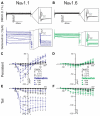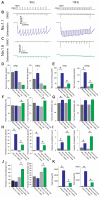Consequences of acute Nav1.1 exposure to deltamethrin
- PMID: 28007400
- PMCID: PMC5447465
- DOI: 10.1016/j.neuro.2016.12.005
Consequences of acute Nav1.1 exposure to deltamethrin
Abstract
Background: Pyrethroid insecticides are the most popular class of insecticides in the world, despite their near-ubiquity, their effects of delaying the onset of inactivation of voltage-gated sodium (Nav) channels have not been well-evaluated in all the mammalian Nav isoforms.
Objective: Here we compare the well-studied Nav1.6 isoforms to the less-understood Nav1.1 in their responses to acute deltamethrin exposure.
Methods: We used patch-clamp electrophysiology to record sodium currents encoded by either Nav1.1 or Nav1.6 channels stably expressed in HEK293 cells. Protocols evaluating both resting and use-dependent modification were employed.
Results: We found that exposure of both isoforms to 10μM deltamethrin significantly potentiated persistent and tail current densities without affecting peak transient current densities, and only Nav1.1 maintained these significant effects at 1μM deltamethrin. Window currents increased for both as well, and while only Nav1.6 displayed changes in activation slope and V1/2 of steady-state inactivation for peak currents, V1/2 of persistent current activation was hyperpolarized of ∼10mV by deltamethrin in Nav1.1 cells. Evaluating use-dependence, we found that deltamethrin again potentiated persistent and tail current densities in both isoforms, but only Nav1.6 demonstrated use-dependent enhancement, indicating the primary deltamethrin-induced effects on Nav1.1 channels are not use-dependent.
Conclusion: Collectively, these data provide evidence that Nav1.1 is indeed vulnerable to deltamethrin modification at lower concentrations than Nav1.6, and this effect is primarily mediated during the resting state.
General significance: These findings identify Nav1.1 as a novel target of pyrethroid exposure, which has major implications for the etiology of neuropsychiatric disorders associated with loss of Nav1.1-expressing inhibitory neurons.
Copyright © 2016 Elsevier B.V. All rights reserved.
Figures




Similar articles
-
The insecticide deltamethrin enhances sodium channel slow inactivation of human Nav1.9, Nav1.8 and Nav1.7.Toxicol Appl Pharmacol. 2021 Oct 1;428:115676. doi: 10.1016/j.taap.2021.115676. Epub 2021 Aug 10. Toxicol Appl Pharmacol. 2021. PMID: 34389319
-
Effects of the β1 auxiliary subunit on modification of Rat Na(v)1.6 sodium channels expressed in HEK293 cells by the pyrethroid insecticides tefluthrin and deltamethrin.Toxicol Appl Pharmacol. 2016 Jan 15;291:58-69. doi: 10.1016/j.taap.2015.12.007. Epub 2015 Dec 19. Toxicol Appl Pharmacol. 2016. PMID: 26708501 Free PMC article.
-
Differential state-dependent modification of rat Na(v)1.6 sodium channels expressed in human embryonic kidney (HEK293) cells by the pyrethroid insecticides tefluthrin and deltamethrin.Toxicol Appl Pharmacol. 2011 Dec 15;257(3):377-87. doi: 10.1016/j.taap.2011.09.021. Epub 2011 Sep 29. Toxicol Appl Pharmacol. 2011. PMID: 21983428 Free PMC article.
-
Effects of Deltamethrin Acute Exposure on Nav1.6 Channels and Medium Spiny Neurons of the Nucleus Accumbens.Toxicology. 2020 Jul;440:152488. doi: 10.1016/j.tox.2020.152488. Epub 2020 May 6. Toxicology. 2020. PMID: 32387285 Free PMC article.
-
Functional reconstitution of rat Nav1.6 sodium channels in vitro for studies of pyrethroid action.Neurotoxicology. 2017 May;60:142-149. doi: 10.1016/j.neuro.2016.03.010. Epub 2016 Mar 21. Neurotoxicology. 2017. PMID: 27013268 Free PMC article. Review.
Cited by
-
Characterization in Potent Modulation on Voltage-Gated Na+ Current Exerted by Deltamethrin, a Pyrethroid Insecticide.Int J Mol Sci. 2022 Nov 25;23(23):14733. doi: 10.3390/ijms232314733. Int J Mol Sci. 2022. PMID: 36499059 Free PMC article.
-
Inhibition of the GSK3β/Nav1.6 complex suppresses early-stage Alzheimer's hyperexcitability.Alzheimers Dement. 2025 Jul;21(7):e70507. doi: 10.1002/alz.70507. Alzheimers Dement. 2025. PMID: 40717647 Free PMC article.
-
Pharmacologically Targeting the Fibroblast Growth Factor 14 Interaction Site on the Voltage-Gated Na+ Channel 1.6 Enables Isoform-Selective Modulation.Int J Mol Sci. 2021 Dec 17;22(24):13541. doi: 10.3390/ijms222413541. Int J Mol Sci. 2021. PMID: 34948337 Free PMC article.
-
Environmental exposure to common pesticide induces synaptic deficit and social memory impairment driven by neurodevelopmental vulnerability of hippocampal parvalbumin interneurons.J Hazard Mater. 2025 Mar 5;485:136893. doi: 10.1016/j.jhazmat.2024.136893. Epub 2024 Dec 16. J Hazard Mater. 2025. PMID: 39706027 Free PMC article.
-
Voltage-Gated Na+ Channels in Alzheimer's Disease: Physiological Roles and Therapeutic Potential.Life (Basel). 2023 Jul 29;13(8):1655. doi: 10.3390/life13081655. Life (Basel). 2023. PMID: 37629512 Free PMC article. Review.
References
-
- Breckenridge CB, Holden L, Sturgess N, Weiner M, Sheets L, Sargent D, et al. Evidence for a separate mechanism of toxicity for the Type I and the Type II pyrethroid insecticides. Neurotoxicology. 2009;30(Suppl. 1):S17–31. - PubMed
-
- Catterall WA, Goldin AL, Waxman SG. International Union of Pharmacology: XLVII. Nomenclature and structure-function relationships of voltage-gated sodium channels. Pharmacol. Rev. 2005;57(4):397–409. - PubMed
-
- Catterall WA. From ionic currents to molecular review mechanisms: the structure and function of voltage-gated sodium channels. Neuron. 2000;26:13–25. - PubMed
MeSH terms
Substances
Grants and funding
LinkOut - more resources
Full Text Sources
Other Literature Sources

